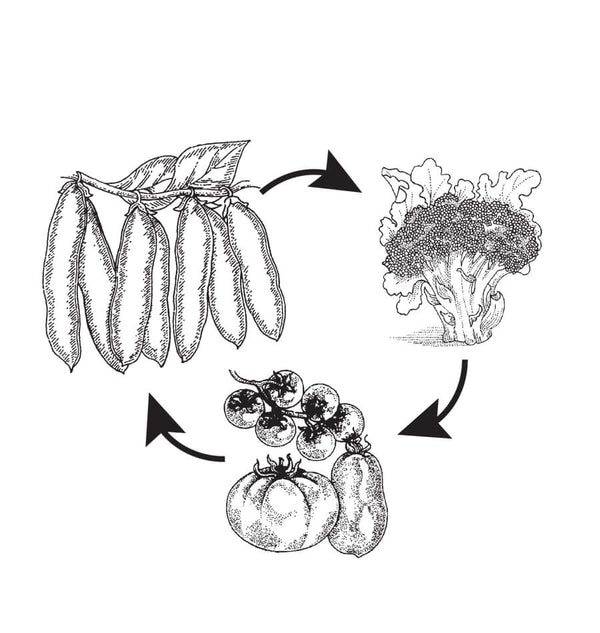Support Food Banks Canada with every dollar spent — 15% sales donated from Black Friday to Cyber Monday.
Time remaining:
Time remaining:

Crop rotation is the practice of not growing plants where similar plants grew the previous year. Crop rotation prevents the build up of pests and diseases and optimizes the use of soil nutrients. Plants from different “families” need different amounts of...
Continue ReadingClubroot is the thickening and distortion of the roots of Brassicas by the soil fungus Plasmodiophora brassicae. Roots are distended and swollen and may appear to be shaped like fingers or tumors. Infected plants will exhibit day wilting (wilting during...
Continue ReadingFrom time to time in early summer, a very large brown and grey moth can be seen in the garden, visiting flowers, particularly large, white, fragrant ones. This conspicuous insect is variously known as the hawk-moth or sphinx moth. Its...
Continue ReadingOrganic gardeners share one challenge that has many faces – how to nurse newly emerged seedlings along to the point when they are strong enough to defend themselves. Because seedlings are so tender and tasty, and low to the ground,...
Continue ReadingIntegrated Pest Management (IPM) Healthy organic gardens are full of bugs. Gardens, and even farms, are ecosystems that maintain their own balance. Thousands of species of insects and other invertebrates make their homes in the soil and on the plants...
Continue ReadingAlthough they arrived from Europe, they’re well at home now in BC’s Lower Mainland and many other regions. This lively beetle (Amphimallon majalis) has an annual life cycle that is worth understanding in an attempt to control it. The beetle...
Continue ReadingIt’s a beautiful summer day. Since sowing your tomato seeds in Spring, you’ve been nurturing your container garden, preparing for harvest. There is nothing like a juicy, summer-ripened tomato fresh from the garden. Finally, it’s time. You will taste the...
Continue ReadingThrough April and May we enjoyed a very robust display of lupins planted around our farmhouse and over the septic berm. The blue and purple flowers were visible from the nearby overpass and painted a streak of colour across the...
Continue ReadingIt’s tempting to imagine, when planting a row of spring radishes, that they will be ready in perfect shape at harvest time, free from blemishes, and wholly uniform in size and shape. Typically, though, this is not the case. There...
Continue ReadingFlea beetles are tiny, hopping, flea-like beetles of the genus Phyllotreta. To deal with flea beetles, it’s best to understand their life cycle. Adults emerge from the soil in spring and feed, laying eggs on plants’ roots. They die off...
Continue ReadingThese gastropods (Snails and Slugs) are a fact of life in damp coastal BC. Two factors, however, can be used to minimize their impact on your organic vegetable garden. First, they shun sunlight, and are mostly active at night. Second,...
Continue ReadingWe hear so much about ants “farming” aphids that we thought we should answer the question, “Do ants farm aphids?” It’s natural for human beings to try to explain an observation of the natural world in terms of human emotions...
Continue ReadingWe’ve often spoken to gardeners who just shake their heads despairingly when we mention growing tomatoes. The Tomato Late Blight fungus really has hit Coastal gardeners hard and, from what we hear, has now even made its way into the Okanagan....
Continue ReadingWhiteflies are members of the order Hemiptera, a group of insects classed together because of the similarity of their sucking mouthparts, with which they feed on the juices of plants. They are closely related to aphids. There are over 1,500...
Continue ReadingThe Lower Mainland of BC tends to enjoy very damp spring and early summer weather. This dampness creates the ideal habitat for Woodlice – often called sow bugs or pill bugs. These are the small, grey, segmented animals that can...
Continue ReadingThe Carrot Rust Fly [CRF] is a weak flying insect pest that feeds its young on 107 different plants in the carrot family, including carrots, celery, parsnips, celeriac, parsley, and dill. The insect (Psila rosae) earned its common name due...
Continue ReadingWireworms represent the larval stage of the click beetles of the family Elateridae. There are around 9,300 species worldwide, but it is a small handful of species that cause problems in our fields and gardens. Click beetles are 1-2cm long,...
Continue ReadingCabbage moth is the name given to the very common Small White butterfly (Pieris rapae) in North America. True Cabbageworms and Cabbage Moth introduced from Europe (Mamestra brassicae) are small and brown, but both types do the same type of damage....
Continue ReadingKnown as greenflies in the UK, there are over 5,000 species of aphids worldwide. Fewer than 10% of known species are agricultural pests, but they are a genuine nuisance. Like whiteflies, aphids are classed in the order Hemiptera because of...
Continue ReadingPowdery Mildew is a fungal disease affects cucumber, squash, calendula, hollyhocks, zinnias, and many other garden plants. Small patches of grey appear on otherwise healthy looking leaves, and if it is not treated right away, the fungus will spread to...
Continue ReadingYes, we sell seeds, but we also encourage seed saving. When you collect your own seed you need to work with nature and watch plants daily in order to catch the ripe seed before the wind whisks it away or...
Continue Reading